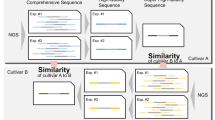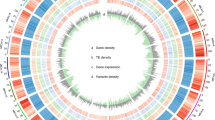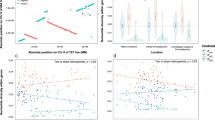Abstract
Investigation of the developmental processes responsible for the evolution of the small-flowered, highly selfing Mimulus micranthus from its large-flowered, mixed-mating progenitor M. guttatus, revealed M. micranthus to have both a shorter duration and a higher rate of bud development. Hence flowers of M. micranthus can be considered as progenetic forms of M. guttatus. Genetic analysis of F1, F2 and backcross generations derived from the cross M. micranthus × M. guttatus provided no evidence for major gene control of development processes responsible for differentiating the two taxa. Furthermore, F2 segregation patterns suggest that duration and rate of development may be genetically independent of one another. Hence, the evolution of small-flowered selfing taxa in Mimulus may reflect selection for rapid development.
Similar content being viewed by others
Article PDF
References
Ambros, V. 1988. Genetic basis for heterochronic variation. In: McKinney, M. L. (ed.) Heterochrony in Evolution pp. 269–285. Plenum Press, New York.
Carr, D E, and Fenster, C B. 1994. Levels of genetic variation and covariation for Mimulus (Scrophulariaceae) floral traits. Heredity, 72, 606–618.
Charlesworth, B. 1992. Evolutionary rates in partially self-fertilizing species. Am Nat, 140, 126–148.
Charlesworth, B, Lande, R, and Slatkin, M. 1982. A neo-Darwinian commentary on macroevolution. Evolution, 36, 474–498.
Cockerham, C C. 1986. Modifications in estimating the number of genes for a quantitative character. Genetics, 114, 659–664.
Coyne, J A, and Lande, R. 1985. The genetic basis of species differences in plants. Am Nat, 126, 141–145.
Darwin, C. 1859. On the Origin of Species, 1st edn. John Murray, London. (Reprinted 1964, Harvard University Press, Cambridge, MA).
Diggle, P K. 1992. Development and the evolution of plant reproductive characters. In: Wyatt, R. (ed.) Ecology and Evolution of Plant Reproduction: New Approaches pp. 326–355. Chapman and Hall, New York.
Doebley, J, and Stec, A. 1991. Genetic analysis of the morphological differences between maize and teosinte. Genetics, 129, 285–295.
Doebley, J, and Stec, A. 1993. Inheritance of the morphological differences between maize and teosinte: comparison of results for two F2 populations. Genetics, 134, 559–570.
Dudash, M R, and Ritland, K. 1991. Multiple paternity and self-fertilization in relation to floral age in Mimulus guttatus (Scrophulariaceae). Am J Bot, 78, 1746–1753.
East, E M. 1916. Studies on size inheritance in Nicotiana. Genetics, 1, 164–176.
Efron, B, and Gong, G. 1983. A leisurely look at the bootstrap, the jackknife and cross-validation. Am Statist, 37, 36–48.
Eldredge, N, and Gould, S J. 1972. Punctuated equilibria: an alternative to phyletic gradualism. In: Schopf, T. J. M. (ed.), Models in Paleobiology pp. 82–115. Freeman, Cooper and Co., San Francisco.
Falconer, D S. 1981. Introduction to Quantitative Genetics, 2nd edn. Longman, London and New York.
Fenster, C B, and Ritland, K. 1992. Chloroplast DNA and isozyme diversity in two Mimulus species (Scrophulariaceae) with contrasting mating systems. Am J Bot, 79, 1440–1447.
Fenster, C B, and Ritland, K. 1994. The quantitative genetics of mating system divergence in the yellow monkeyflower species complex. Heredity, 73, 422–435.
Fisher, R A. 1958. The Genetical Theory of Natural Selection. Dover Publications, New York.
Goldschmidt, R B. 1940. The Material Basis of Evolution. Yale University Press, New Haven, CT.
Goodwin, R H. 1944. The inheritance of flowering time in a short-day species, Solidago sempervirens. Genetics, 29, 503–519.
Gottlieb, L D. 1973. Genetic differentiation, sympatric speciation, and the origin of a diploid species of Stephanomeria. Am J Bot, 50, 545–553.
Gottlieb, L D. 1977. Electrophoretic evidence and plant systematics. Ann Mo Bot Gard, 64, 161–180.
Gottlieb, L D. 1981. Electrophoretic evidence and plant populations. In: Reinhold, L., Harborne, J. B and Swain, T (eds) Progress in Phytochemistry, vol. 7, pp. 1–46. Pergamon, Oxford.
Gottlieb, L D. 1984. Genetics and morphological evolution in plants. Am Nat, 123, 681–709.
Gottlieb, L D. 1985. Reply to Coyne and Lande. Am Nat, 126, 146–150.
Gould, S J. 1977. Ontogeny and Phylogeny. Harvard University Press, Cambridge, MA.
Gould, S J. 1988. The uses of heterochrony. In: McKinney, M. L. (ed.) Heterochrony in Evolution, pp. 1–13. Plenum Press, New York.
Guerrant, E O, Jr. 1988. Heterochrony in plants: The intersection of evolution, ecology and ontogeny. In: McKinney, M. L. (ed.) Heterochrony in Evolution, pp. 111–133. Plenum Press, New York.
Hill, J P, Lord, E M, and Shaw, R G. 1992. Morphological and growth rate differences among outcrossing and self-pollinating races of Arenaria uniflora (Caryophylaceae). J Evol Biol, 5, 559–573.
Holtsford, T P, and Ellstrand, N C. 1992. Genetic and environmental variation in floral traits affecting outcrossing rate in Clarkia tembloriensis (Onagraceae). Evolution, 46, 216–225.
Humphreys, M O, and Nicholls, M K. 1984. Relationships between tolerance to heavy metals in Agrostis capillaries (= A. tenuis Sibth.). NewPhytol, 98, 177–190.
Kacser, H, and Burns, J A. 1981. The molecular basis of dominance. Genetics, 97, 639–666.
Kaiser, S. 1935. The factors controlling shape and size in Capsicum fruits; a genetic and developmental analysis. Bull Torrey Bot Club, 62, 433–454.
Lande, R. 1981. The minimum number of genes contributing to quantitative variation between and within populations. Genetics, 99, 541–553.
Lande, R. 1983. The response to selection on major and minor mutations affecting a metrical trait. Heredity, 50, 47–65.
Lande, R, and Arnold, S J. 1983. The measurement of selection on correlated characters. Evolution, 37, 1210–1226.
Lord, E M, and Hill, J P. 1987. Evidence for heterochrony in the evolution of plant form. In: Raff, R. A. and Raff, E. C. (eds) Development as an Evolutionary Process, pp. 47–70. Alan R. Liss, New York.
Macnair, M R, and Cumbes, Q J. 1989. The genetic architecture of interspecific variation in Mimulus. Genetics, 122, 211–222.
Marshall, D E, and Abbott, R J. 1982. Polymorphism for outcrossing frequency at the ray floret locus in Senecio vulgaris L.I. Evidence. Heredity, 48, 227–235.
Mather, K, and Jinks, J L. 1982. Biometrical Genetics, 3rd edn. Chapman and Hall, London.
Munz, P A, and Keck, D D. 1973. A California Flora and Supplement. University of California Press, Berkeley and Los Angeles.
Orr, H A, and Coyne, J A. 1992. The genetics of adaptation: a reassessment. Am Nat, 140, 725–742.
Ritland, K, and Jain, S. 1984. The comparative life histories of two annual Limnanthes species in a temporally variable environment. Am Nat, 124, 656–679.
Ritland, C, and Ritland, K. 1989. Variation of sex allocation among eight taxa of the Mimulus guttatus species complex. (Scrophulariaceae). Am J Bot, 76, 1731–1739.
Sawhney, V K. 1992. Floral mutants in tomato: development, physiology, and evolutionary implications. Can J Bot, 70, 701–707.
Schwarz-Sommer, Z, Huijser, P, Nacken, W, Saedler, H, and Sommer, H. 1991. Genetic control of flower development by homeotic genes in Antirrhinum majus. Science, 250, 931–936.
Shore, J S, and Barrett, S C H. 1990. Quantitative genetics of floral characters in homostylous Turnera ulmifolia var. angustifolia Willd. (Turneraceae). Heredity, 64, 105–112.
Sinnott, E W. 1935. Evidence for the existence of genes controlling shape. Genetics, 20, 12–21.
Sinnott, E W. 1936. A developmental analysis of inherited shape differences in Cucurbit fruits. Am Nat, 70, 245–254.
Slatkin, M. 1987. Quantitative genetics of heterochrony. Evolution, 41, 799–811.
Smith, H H. 1950. Developmental restrictions on recombinations in Nicotiana. Evolution, 4, 202–211.
Takhtajan, A. 1976. Neoteny and the origin of flowering plants. In: Beck, C. B. (ed.) Origin and Early Evolution of Angiosperms pp. 207–219. Columbia University Press, New York.
Vickery, R K. 1978. Case studies in the evolution of species complexes in Mimulus. Evol Biol, 11, 405–507.
Wright, S. 1968. Evolution and the Genetics of Populations vol 1, Genetic and Biometrie Foundations. University of Chicago Press, Chicago.
Wright, S. 1978. Evolution and the Genetics of Populations vol 4, Variability Within and Among Natural Populations. University of Chicago Press, Chicago.
Wyatt, R. 1988. Phylogenetic aspects of the evolution of self-pollination. In: Gottlieb, L. D. and Jain, S. K. (eds) Plant Evolutionary Biology, pp. 109–131. Chapman and Hall, New York.
Zeng, Z-B, Houle, D, and Cockerham, C C. 1990. How informative is Wright's estimator of the number of genes affecting a quantitative character? Genetics, 126, 235–247.
Author information
Authors and Affiliations
Rights and permissions
About this article
Cite this article
Fenster, C., Diggle, P., Barrett, S. et al. The genetics of floral development differentiating two species of Mimulus (Scrophulariaceae). Heredity 74, 258–266 (1995). https://doi.org/10.1038/hdy.1995.39
Received:
Issue date:
DOI: https://doi.org/10.1038/hdy.1995.39
Keywords
This article is cited by
-
How a heterostylous plant species responds to life on remote islands: a comparative study of the morphology and reproductive biology of Waltheria ovata on the coasts of Ecuador and the Galápagos Islands
Evolutionary Ecology (2013)
-
Mimulus is an emerging model system for the integration of ecological and genomic studies
Heredity (2008)
-
Comparative floral morphometrics in day-flowering, night-flowering and self-pollinated Caryophylloideae (Agrostemma, Dianthus, Saponaria, Silene, and Vaccaria)
Plant Systematics and Evolution (2006)
-
Genetic basis of speed of development in Senecio vulgaris L var. vulgaris, S. vulgaris ssp. denticulatus (O.F. Muell.) P.D. Sell, and Senecio vernalis Waldst. & Kit.
Heredity (1996)



